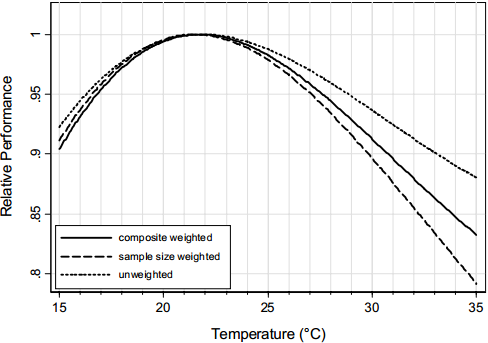
What should a thermostat be set at to maximize occupant performance for an office full of people or a classroom full of students? Are people more productive when temperatures are a little chilly to avoid drowsiness? In many work environments, workers are the single largest expense (it often dwarfs the cost of the building itself), so minor improvements to productivity may have major impacts on the bottom line!
There are a number of factors to consider. Measurable conditions, such as air temperature, air movement, relative humidity, temperature stratification, and radiant temperatures, are the easiest to monitor and control. More challenging are the variations between people in terms of their subjective perception of the space, clothing levels, and their current metabolic rate (which varies from person to person and as activity level changes).
Space Temperature
The primary (and easiest) component of thermal comfort is simply the ambient air temperature. If a room is either 45F or 90F, performance will suffer, for obvious reasons. Researchers have studied the effect of space temperature both in a lab and in a more natural work environment[1]. This research indicates performance rises as the temperature increases and approaches 70F (21C), tapers off, and then begins to decrease as temperatures rise past 75F (24C) – see the Relative Performance vs. Temperature chart. This is not coincidentally where most people (when dressed in long sleeve clothing) report feeling comfortable[2].
Other Factors
Anyone who designs or manages heating and cooling systems knows that solving comfort complaints requires more than just controlling the temperature to somewhere in that temperature band. All the above factors play a role in people’s comfort, so one or two measurements won’t be enough to ensure everyone’s comfortable. Common comfort issues include: high air velocity which produces a cooling effect; proximity to cold surfaces, especially large windows which suck the heat out of occupants by radiation; and temperature stratification, especially where heat is delivered via warm air coming from or near the ceiling. Other issues can include localized hot or cold spots due to poor distribution and/or mixing.
The fact is, given fixed identical air conditions and surroundings, some people may be too cool while at the same time, others are bordering on uncomfortable warmth.
What’s the best approach?
Proper HVAC design is always the best bet to achieving comfortable spaces. But if the space is already built and operating, ask the occupants! Identify spaces that have comfort issues and check for problems. Is the thermostat located right behind a coffee pot or in direct sunlight? Move that stat! Are people right next to an old insulated wall with single pane windows? Move them or find a way to reduce the radiant heating/cooling effects (for example, by replacing diffusers with linear ones near the perimeter). Was a wall built or moved, isolating a space with no dedicated temperature control? This happens all the time. Solutions for this may be wide and varied, but beware of the band aid approach of adding independent supplemental heating and cooling. These are classic causes for energy waste.
[1] http://eaei.lbl.gov/sites/all/files/LBNL-60946.pdf
[2] ASHRAE Standard 55




